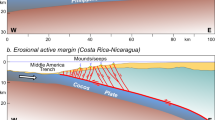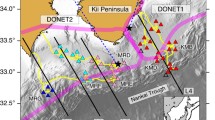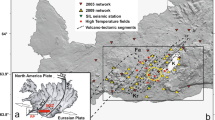Abstract
At the continental margin of north Costa Rica and Nicaragua, the strongly hydrated Cocos Plate subducts beneath the Caribbean Plate. From the downgoing Cocos plate fluids are released through extensional fractures in the overriding plate. At the seafloor, they form fluid seeps, mounds and other types of fluid expulsion. Using an offshore temporary seismic network, we investigated seismicity possibly related to these processes and observed several swarms of earthquakes located on the continental slope trenchward of the seismogenic zone of S Nicaragua. The seismicity occurred within the downgoing plate, near the plate interface and in the overriding plate. We interpret these swarm events as an expression of pore pressure propagation under critical stress conditions driven by fluid release from the downgoing plate. In order to estimate hydraulic diffusivity and permeability values, we applied a theory developed for injection test interpretation to the spatio-temporal development of the swarms. The resulting diffusivity and permeability values are in the ranges of 28–305 m²/s and 3.2 × 10−14 m²–35.1 × 10−14 m², respectively, applying to the continental and oceanic crust near the plate interface. These values are somewhat larger than observed in drill logs on the margin wedge off north Costa Rica, but of comparable magnitude to values estimated for the Antofagasta 1995 earthquake aftershock sequence.






Similar content being viewed by others
References
Berhorst A (2006) Die Struktur des aktiven Kontinentalhangs vor Nicaragua und Costa Rica—marin-seismische Steil- und Weitwinkelmessungen, Ph.D. thesis, Christian-Albrechts-University, Kiel
Biot MA (1962) Mechanics of deformation and acoustic propagation in porous media. J Appl Phys 33:1482–1498
Bohrmann G, Heeschen K, Jung C, Weinrebe W, Baranov B, Cailleau B, Heath R, Vühnerbach V, Hort M, Masson D, Trummer I (2002) Widespread fluid expulsion along the seafloor of the Costa Rica convergent margin. Terra Nova 14(2):69–79
Brown KM, Tryon MD, DeShon HR, Dorman LM, Schwartz SY (2005) Correlated transient fluid pulsing and seismic tremor in the Costa Rica subduction zone. Earth Planet Sci Lett 238:189–203. doi:10.1016/j.epsl.2005.06.055
deMets Ch, Gordon RG, Argus DF, Stein S (1994) Effects of recent revisions to the geomagnetic reversal time scale on estimates of current plate motions. Geophys Res Lett 31(20):2191–2194
DeShon HR, Schwartz SY (2004) Evidence for serpentinization of the forearc mantle wedge along the Nicoya Peninsula, Costa Rica. Geophys Res Lett 31(L21611):4
DeShon HR, Schwartz SY, Newman AV, González V, Protti M, Dorman LM, Dixon TH, Sampson DE, Flueh ER (2006) Seismogenic zone structure beneath the Nicoya Peninsula, Costa Rica, from three-dimensional local earthquake P- and S-wave tomography. Geophys J Int 164(1):109–124
Dinc AN, Rabbel W, Flueh ER, Taylor W (2011) Mantle wedge hydration in Nicaragua from local earthquake tomography. Geophys J Int 186(1):99–112
Fekete N (2006) Dewatering through mud mounds on the continental fore-arc of Costa Rica, Ph.D. thesis, Christian-Albrechts-University, Kiel
Fisher AT (1998) Permeability within basaltic oceanic crust. Rev Geophys 36(2):143–182
Gebrande H (1982) Elastic wave velocities and constants of elasticity of rocks and rock forming minerals. In: Angenheister G (ed) Physical properties of rocks, Landolt-Börnstein numerical data and functional relationships in science and technology V1b. Springer, Berlin, pp 1–99
Grevemeyer I, Ranero CR, Flueh ER, Kläschen D, Bialas J (2007) Passive and active seismological study of bending-related faulting and mantle serpentinization at the Middle America trench. Earth Planet Sci Lett 258:528–542
Han X, Suess E, Sahling H, Wallmann K (2004) Fluid venting activity on the Costa Rica margin: new results from authigenic carbonates. Int J Earth Sci (Geol Rundschau) 93:596–611
Hensen Ch, Wallmann K, Schmidt M, Ranero CR, Suess E (2004) Fluid expulsion related to mud extrusion off Costa Rica—a window to the subducting slab. Geology 32(3):201–204
Hensen C, Nuzzo M, Hornibrook E, Pinheiro LM, Bock B, Magalhães VH, Brückmann W (2007) Sources of mud volcano fluids in the Gulf of Cadiz—indications for hydrothermal imprint. Geochim Cosmochim Acta 71:1232–1248
Huenges E, Zimmermann G (1999) Rock permeability and fluid pressure at the KTB. Oil Gas Sci Technol-Rev IFP 54(6):689–694
Hyndman RD, Yamano M, Oleskevich DA (1997) The seismogenic zone of subduction thrust faults. Island Arc 6:244–260
International Seismological Centre (2011) On-line Bulletin, http://www.isc.ac.uk, International Seismological Centre, Thatcham
Ivandic M, Grevemeyer I, Berhorst A, Flueh ER, McIntosh K (2008) Impact of bending-related faulting on the seismic properties of the incoming oceanic plate offshore of Nicaragua. J Geophys Res 113
Ivandic M, Grevemeyer I, Bialas J, Petersen CJ (2010) Serpentinization in the trench-outer rise region offshore of Nicaragua: constraints from seismic refraction and wide-angle data. Geophys J Int 180(3):1253–1264
Kahn LM, Silver EA, Orange D, Kochevar R, McAdoo B (1996) Surficial evidence of fluid expulsion from the Costa Rica Accretionary Prism. Geophys Res Lett 23(8):887–890
Karaca D, Hensen C, Wallmann K (2010) Controls on authigenic carbonate precipitation at cold seeps along the convergent margin off Costa Rica. Geochem Geophys Geosyst 11:Q08S27
Klaucke I, Masson DG, Petersen CJ, Weinrebe W, Ranero CR (2008) Multifrequency geoacoustic imaging of fluid escape structures offshore Costa Rica: Implications for the quantification of seep processes. Geochem Geophys Geosyst 9
Li YD, Rabbel W, Wang R (1994) Investigation of permeable fracture zones by tube-wave analysis. Geophys J Int 116:739–753
Mau S, Sahling H, Rehder G, Suess E, Linke P, Soeding E (2006) Estimates of methane output from mud extrusions at the erosive convergent margin off Costa Rica. Mar Geol 225(1–4):129–144
Moerz T, Fekete N, Kopf A, Brueckmann W, Kreiter S, Huehnerbach V et al (2005) Styles and productivity of mud diapirism along the Middle American margin, part II. Mound Culebra and Mounds 11 and 12. In: Mud volcanoes, geodynamics and seismicity, NATO science series: IV: earth and environmental sciences, vol 51, chap 1, pp 49–76
Oleskevich DA, Hyndman RD, Wang K (1999) The updip and downdip limits to great subduction earthquakes: thermal and structural models of Cascadia, south Alaska, SW Japan and Chile. J Geophys Res 104:14965–14991
Petersen CJ, Klaucke I, Weinrebe W, Ranero CR (2009) Fluid seepage and mound formation offshore Costa Rica revealed by deep-towed sidescan sonar and sub-bottom profiler data. Mar Geol 266(1–4):172–181
Ranero C, von Huene R (2000) Subduction erosion along the Middle America convergent margin. Nature 404:748–752
Ranero CR, Villaseñor A, Phipps Morgan J, Weinrebe W (2005) Relationship between bend-faulting at trenches and intermediate-depth seismicity. Geochem Geophys Geosys 6(12)
Ranero C, Vannucchi P, von Huene R (2007) Drilling the seismogenic zone of an Erosional convergent margin: IODP Costa Rica Seismogenesis project CRISP, in: abstracts and reports from the IODP/ICDP workshop on fault zone drilling. In: Ito H, Behrmann JH, Hickman S, Tobin H, Kimura G (eds.) Scientific drilling: special issue, no. 1, pp 51–54
Ranero CR, Grevemeyer I, Sahling H, Barckhausen U, Hensen Ch, Wallmann K, Weinrebe W, Vannucchi P, von Huene R, McIntosh K (2008) Hydrogeological system of erosional convergent margins and its influence on tectonics and interpolate seismogenesis. Geochem Geophys Geosys 9:3. doi:10.1029/2007GC001679
Rothert E, Shapiro SA, Buske S, Bohnhoff M (2003) Mutual relationship between microseismicity and seismic reflectivity: case study at the German Continental deep drilling site (KTB). Geophys Res Lett 30(17):1893
Rüpke LH, Phipps Morgan J, Hort M, Connolly JAD (2002) Are the regional variations in Central American arc lavas due to differing basaltic versus peridotitic slab sources of fluids? Geology 30(11):1035–1038
Rüpke LH, Phipps Morgan J, Hort M, Connolly JAD (2004) Serpentine and the subduction zone water cycle. Earth Planet Sci Lett 223:17–34. doi:10.1016/j.epsl.2004.04.018
Saffer DM, Tobin HJ (2011) Hydrogeology and Mechanics of Subduction Zone Forearcs: fluid flow and pore pressure. Annu Rev Earth Planet Sci 39:157–186
Saffer DM, Silver EA, Fisher AT, Tobin H, Moran K (2000) Inferred pore pressures at the Costa Rica subduction zone: implications for dewatering processes. Earth Planet Sci Lett 177:193–207
Sahling H, Masson DG, Ranero CR, Hühnerbach V, Weinrebe W, Klaucke I, Bürk D, Brückmann W, Suess E (2008) Fluid seepage at the continental margin offshore Costa Rica and southern Nicaragua. Geochem Geophys Geosys 9(Q05S05). doi:10.1029/2008GC001978
Schmidt M, Hensen C, Mörz T, Müller C, Grevemeyer I, Wallmann K, Mau S, Kaul N (2005) Methane hydrate accumulation in “Mound 11” mud volcano, Costa Rica forearc. Mar Geol 216(1–2):83–100. doi:10.1016/j.margeo.2005.01.001
Shapiro S (2000) An inversion for fluid transport properties of three-dimensionally heterogeneous rocks using microseismicity. Geophys J Int 143:931–936
Shapiro SA, Huenges E, Borm G (1997) Estimating the crust permeability from fluid-injection-induced seismic emission at the KTB site. Geophys J Int 131:F15–F18
Shapiro SA, Audigane P, Royer J–J (1999) Large-scale in situ permeability tensor of rocks from induced microseismicity. Geophys J Int 137:207–213
Shapiro SA, Rothert E, Rath V, Rindschwentner J (2002) Characterization of fluid transport properties of reservoirs using induced microseismicity. Geophysics 67(1):212–220
Shapiro SA, Patzig R, Rothert E, Rindschwentner J (2003) Triggering of seismicity by pore-pressure perturbations: permeability-related signatures of the phenomenon. Pure Appl Geophys 160:1051–1066
Shapiro SA, Kummerow J, Dinske C, Asch G, Rothert E, Erzinger J, Kümpel H–H, Kind R (2006) Fluid induced seismicity guided by a continental fault: injection experiment of 2004/2005 at the German Deep Drilling Site (KTB). Geophys Res Lett 33:L01309
Soeding E, Wallmann K, Suess E, Flüh E (2003) FS Meteor, cruise report M54/2-3: Caldera-Curacao: GEOMAR report 111, p 366
Spinelli GA, Underwood MB (2004) Character of sediments entering the Costa Rica subduction zone: implications for partitioning of water along the plate interface. Island Arc 13:432–451
Talukder AR, Bialas J, Klaeschen D, Buerk D, Brueckman W, Reston T, Breitzke M (2007) High-resolution, deep tow, multichannel seismic and sidescan sonar survey of the submarine mounds and associated BSR off Nicaragua pacific margin. Mar Geol 241(1–4):33–43
Townend J, Zoback M (2000) How faulting keeps the crust strong. Geology 40:399–402
Vannucchi P, Scholl DW, Meschede M, McDougall-Reid K (2001) Tectonic erosion and consequent collapse of the Pacific margin of Costa Rica: combined implications from ODP Leg 170, seismic offshore data, and regional geology of the Nicoya Peninsula. Tectonics 20(5):649–668
Vannucchi P, Ranero CR, Galeotti S, Straub SM, Scholl DW, McDougall-Reid K (2003) Fast rates of subduction erosion along the Costa Rica Pacific margin: implications for nonsteady rates of crustal recycling at subduction zones. J Geophys Res 108(B11)
von Huene R, Ranero CR, Weinrebe W, Hinz K (2000) Quaternary convergent margin tectonics of Costa Rica, segmentation of the Cocos Plate, and Central American volcanism. Tectonics 19(2):314–334
Waldhauser F (2001) hypoDD—a program to compute double-difference hypocenter locations, USGS open file report 01–113
Waldhauser F, Ellsworth WL (2000) A double-difference earthquake location algorithm: method and application to the northern Hayward fault. Bull Seism Soc Am 90:1353–1368
Waldhauser F, Schaff D, Diehl T, Engdahl R (2012) Splay faults imaged by fluid-driven aftershocks of the 2004 Mw 9.2 Sumatra-Andaman earthquake. Geology 40:243–246
Walther CHE, Flueh ER, Ranero CR, von Huene R, Strauch W (2000) Crustal structure across the Pacific margin of Nicaragua: evidence for ophiolitic basement and a shallow mantle sliver. Geophys J Int 141(3):759–777
Acknowledgments
This publication is contribution no. 250 of the Sonderforschungsbereich 574 “Volatiles and Fluids in Subduction Zones” at Kiel University. Florian Wolf helped greatly with the data processing. We thank the ship and crew of the RV Meteor for their assistance in the deployment of the stations. For the retrieval, we are indebted to the Costa Rican coast guard, in particular, Comandante R. Peralta for providing their ship and crew for the retrieval of part of the stations. We also sincerely thank the crew of Papagayo Seafood vessel for their immense assistance with the other part of the retrieval, and for their hospitality on board.
Author information
Authors and Affiliations
Corresponding author
Rights and permissions
About this article
Cite this article
Thorwart, M., Dzierma, Y., Rabbel, W. et al. Seismic swarms, fluid flow and hydraulic conductivity in the forearc offshore North Costa Rica and Nicaragua. Int J Earth Sci (Geol Rundsch) 103, 1789–1799 (2014). https://doi.org/10.1007/s00531-013-0960-y
Received:
Accepted:
Published:
Issue Date:
DOI: https://doi.org/10.1007/s00531-013-0960-y




